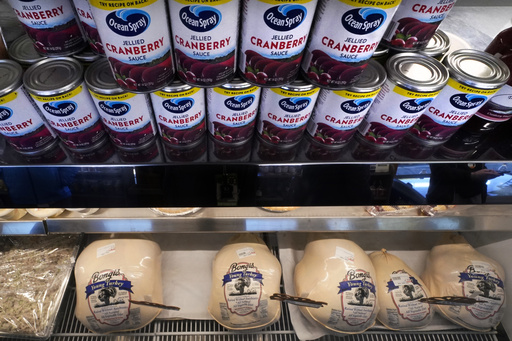
MIDDLEBORO, Mass. — Just weeks ahead of Thanksgiving, the vibrant red cranberries are now floating atop the Rocky Meadow bog in southeastern Massachusetts, setting the scene for the upcoming holiday meals.
The water has taken on a pinkish hue due to the ripe berries. Workers, standing waist-deep in the bog, carefully guide the cranberries toward a pump that extracts them from the water, transferring them to waiting trucks. At the processing location, the berries undergo a thorough washing and separating process, removing any leaves and vines before being sent out to become cranberry sauce, juice, or sweetened dried fruits.
Cranberries, which thrive in wetland conditions, begin their growth in May. When it’s time for the harvest, farmers flood the bogs and deploy harvesting machines that vibrate the fruits off the vines. Afterward, more water is added so that the released cranberries can float to the surface for easy collection.
“This year’s harvest has been quite favorable. We’ve seen a significant crop,” remarked Steve Ward, a cranberry farmer with a family legacy, from the banks of his bog.
The harvest season spans from late September to early November, and Ward is on track to yield between 15,000 and 20,000 barrels—his most productive output in three years. A vast majority, about 80%, of these cranberries will end up with Ocean Spray, one of the leading producers of cranberry products in the nation.
Ward’s bog is part of nearly 300 different cranberry farms scattered across Massachusetts, which collectively span around 14,000 acres. This year, it’s anticipated that farmers will generate 2.2 million barrels of cranberries, each barrel weighing approximately 100 pounds (45 kilograms). This figure marks a 12% increase from last year’s numbers. Massachusetts stands as the second-largest cranberry producer in the U.S., following Wisconsin, with an industry presence stretching back to the 1800s.
Although substantial, the cranberry farming sector continues to face numerous hurdles, including trade disputes, declining prices, and oversupply. Some farmers have been forced to sell their bogs, while others, like Ward, are diversifying their operations with the installation of solar panels around their fields. He has already developed two solar sites adjacent to his bogs and is contemplating deploying floating solar panels on his water reservoirs.
Adapting to climate change has also become essential for these farmers. The Massachusetts Cranberries organization highlights concerns that changing weather patterns could negatively impact this year’s yield.
“We’ve dealt with hot temperatures and one of the longest dry spells on record,” Ward stated. “We’ve been experiencing clusters of 90-degree days, which are not ideal for cranberry plants. The warmer average temperatures at night are particularly concerning, as cranberries thrive in cooler nighttime conditions.”
